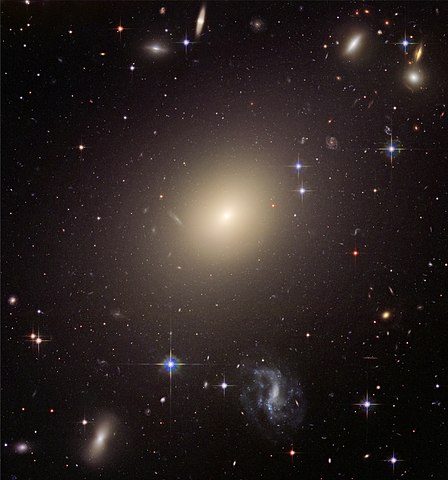Elliptical galaxies are one of the two primary types of galaxies found in the universe, with the other being spiral galaxies. They possess their own unique marvels and provide valuable insights into the formation and evolution of galaxies. Here are some of the marvels of elliptical galaxies and an exploration of their formation:
1. Smooth, Elliptical Shape: As the name suggests, elliptical galaxies are characterized by their smooth, elliptical shape, unlike the spiral arms seen in spiral galaxies. This shape ranges from nearly spherical (E0) to highly elongated (E7).
2. Stellar Populations: Elliptical galaxies are typically composed of older stars and contain relatively little gas and dust compared to spiral galaxies. The stars within them have often exhausted their fuel for nuclear fusion, resulting in a lack of ongoing star formation.
3. Size and Mass: Elliptical galaxies vary in size and mass, with some being relatively small and others among the most massive galaxies in the universe. Some elliptical galaxies are even larger than our Milky Way.
4. Supermassive Black Holes: Many elliptical galaxies are known to harbor supermassive black holes at their centers. These black holes can have masses ranging from millions to billions of times that of our Sun.
5. Galaxy Clusters: Elliptical galaxies are frequently found in galaxy clusters, large congregations of galaxies bound together by gravity. Their presence in clusters provides opportunities for studying the interactions and dynamics of galaxies within these environments.
Formation of Elliptical Galaxies:
The formation of elliptical galaxies is a complex process influenced by several factors:
1. Galaxy Mergers: One leading theory for the formation of elliptical galaxies is galaxy mergers. When two or more galaxies collide and merge, they can lose their original spiral structure and become an elliptical galaxy. During the merger, gas and dust are often compressed, triggering a burst of star formation. Over time, this leads to the depletion of gas and the aging of stars, resulting in an elliptical galaxy dominated by older stars.
2. Feedback from Active Galactic Nuclei (AGN): In some cases, the presence of a supermassive black hole at the center of a galaxy can play a role in shaping the galaxy’s morphology. AGN can release enormous amounts of energy, affecting the surrounding gas and stars and potentially disrupting the galaxy’s structure.
3. Environmental Effects: The environment in which a galaxy resides, such as a dense cluster, can also influence its evolution. Interactions with neighboring galaxies, gravitational tugs, and tidal forces can strip a galaxy of its gas and trigger transformations into an elliptical shape.
4. Early Universe: In the early universe, elliptical galaxies may have formed from the rapid collapse of dense regions of gas and dark matter. These early structures could have given rise to the elliptical shape we observe today.
Understanding the formation and evolution of elliptical galaxies is essential for unraveling the complex story of how galaxies have developed over cosmic time. By studying these galaxies, astronomers gain insights into the processes that have shaped the universe’s large-scale structure and the role that mergers, feedback, and environmental factors play in galaxy evolution.










